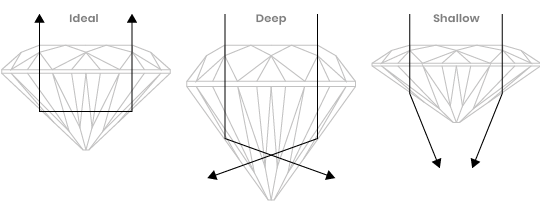Diamond Education
The 4 C'sThe Privée Diamond
A Cut Above
To exhibit their beauty, rough diamonds must be cut & polished by master cutters to show the fire, scintillation, and brilliance they are known for.
The quality of a diamond’s CUT is considered the most important of the four 4Cs in determining the beauty and value of a diamond.
We at Privée Diamonds Direct take pride in searching globally and hand-selecting the top 1% of polished diamonds based on their proportion, symmetry, polish and total beauty, as well as their ethical origin.

Understanding the 4 C’s of Diamond Shopping
All diamonds are unique in their captivating beauty and mystery.
Each diamond has its own transformative journey from within the depths of the earth to a cherished gemstone.
Yet, all diamonds share certain features that allow us to compare and evaluate them.
These features – cut, color, clarity and carat – are the 4C’s by which all diamonds are evaluated, natural and lab grown.
Clarity
Clarity is a measure of the existence and the visual appearance of internal characteristics of a diamond called inclusions, and surface defects called blemishes.
As diamonds are formed under tremendous heat and pressure, it is extremely rare to find a diamond that lacks any internal and external characteristics.
These characteristics are by-products of its formation and help gemologists separate diamonds by a clarity scale created by the Gemological Institute of America.
Most inclusions present in gem-quality diamonds do not affect the diamonds’ performance or structural integrity.
Diamonds with higher clarity grades are more valued, with the exceedingly rare Flawless graded diamond fetching the highest price.


Cut & Shape
The term “polish & symmetry” usually are marked on the diamond certificate. The polish describes the smoothness of the diamond’s facets, and the symmetry refers to alignment of the facets on the diamond.
A poorly cut stone will be less luminous, and its value will drop.
SHAPE
Diamonds are cut into a variety of shapes based on the shape of the rough, the ability to accentuate the brilliance of the stone, and to maximize the polished yield result.
The most popular diamond cut is the modern Round Brilliant, with 57 facets arrangements and proportions that have been developed and perfected through many years of study.
Diamonds which are not cut into a round brilliant shape are known as “Fancy Cuts.” Popular fancy cuts include the Ovel, Pear, Cushion, Radiant and the Marquise Cut.


Color
Although many people think of gem-quality diamonds as colorless, truly colorless diamonds are very rare. Most diamonds are nearly colorless with tints of yellow or brown.
Diamonds come in a variety of colors like white, blue, yellow, orange, red, green, pink, purple, brown, and even black.
Diamonds that are of intense color, such as yellow, brown, pink or any other color, are called Fancy Color Diamonds and are very rare. The degree to which diamonds exhibit body color is one of the four value factors by which diamonds are assessed.
Color grades are determined by comparing each diamond to a master set. Each letter grade represents how noticeable a color is.


Carat (Size)
The carat weight measures the mass of a diamond. The point unit—equal to one one-hundredth of a carat (0.01 carat) is commonly used for diamonds of less than one carat. 0.75 = 75 point 1/2 carat = 50 points.
The word carat in English came from Greek word kerátion, literally meaning “carob seed” which was used as a unit of weight.
All being equal, the price per carat increases with carat weight, since larger diamonds are both rare and more desirable.
The price does not increase linearly with increasing size. Instead, there are sharp jumps around milestone carat weights. For an example, a 0.95 carats diamond may have a significantly lower price per carat than a comparable 1.05 carats diamond.



